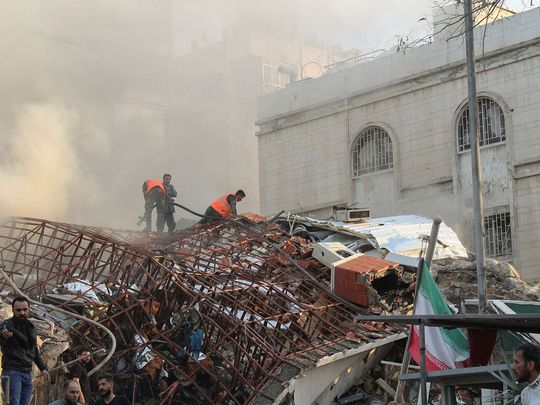
The Gaza war has significantly impacted Iran’s military presence in Syria, prompting Tehran to strategise the evacuation of IRGC members and relocate its prominent headquarters from rural Damascus to areas near Lebanon. This decision comes in the wake of Israeli air strikes that resulted in the killing of numerous senior commanders.
The war has also strained relations between the two countries. Damascus’s adoption of a “neutral” stance during the conflict has led to a noticeable decline in relations, as evidenced by the rift between the governments of Iran and Syria.
In addition, there are growing suspicions from Tehran regarding the Syrian security services possibly leaking information about the movements of Iranian officers. Also, Tehran expressed concern about Damascus’ response to signs of Arab rapprochement and its desire to ease out of the Iranian bottleneck by normalising relations with the West.
On April 1 last year, Israel targeted the Iranian consulate adjacent to its embassy on the Mezzeh highway in Damascus, killing seven individuals, including Mohammad Reza Zahedi, Commander of the Quds Force in Syria and Lebanon.
Fear and evacuation plans
Local individuals accompanying an Iranian adviser in Syria have revealed the deep concerns they harbour for their safety following repeated Israeli air strikes. Sources from non-Syrian militias affiliated with Iran, present in the Damascus countryside, have disclosed that Iran is formulating plans to evacuate the IRGC from Syria due to the escalating Israeli pressure.
The targeting of the Iranian consulate in Damascus, which Israel described as “ IRGC operations room” in Syria and Lebanon, occurred after Israel intensified its campaign against the Iranian military presence in Syria since the start of war in the Gaza Strip last October.
Israeli raids and missiles now target not only Iranian positions and military militias in border areas but also individuals ranging from operatives and militia leaders to Revolutionary Guard commanders across all regions of the Syrian government.
Sayyeda Zeinab: Headquarters of the Iranians
In the Sayyida Zeinab area south of Damascus, traditionally a stronghold for Iranian military presence and their affiliated militias, there has been a noticeable disappearance of armed operatives following significant Israeli military actions.
This has become even more evident after the killing of Razi Mousavi, commander of the IRGC liaison force in Syria, during an Israeli raid last December and a subsequent air strike in January that killed an IRGC intelligence official and a Quds Force officer in the Mezzeh neighbourhood.
According to Asharq Al Awsat newspaper, the military deployment in Sayyida Zeinab is now primarily limited to Hezbollah, particularly around the shrine area, which continues to attract Shiite visitors from various countries, including Iran, Iraq, Lebanon, Pakistan, and Afghanistan.
Despite these changes, Iranian Ambassador Hossein Akbari affirmed post-Mousavi’s death that Iran has no intention of withdrawing militarily from Syria. The Syrian newspaper Al Watan, known for its proximity to the Syrian government, quoted Akbari, emphasising the continued and unchanged presence of Iranian military advisers in Syria.
Since the beginning of the Syrian conflict, Iran has been a significant political, military, and economic supporter of the Syrian regime. The Syrian Observatory for Human Rights claimed that approximately 3,000 members of Iran’s IRGC, including both fighters and military advisers, are currently stationed in Syria. Nonetheless, Tehran officially characterises these personnel merely as “advisers” to assist Syrian government forces.
Leadership and influence
Meanwhile, Hezbollah plays a pivotal role as the dominant force among Shiite militias in Syria, holding a significant position just under the commanders of the Iranian Revolutionary Guards. They are actively involved in community relations, such as renting apartments and villas for Iranian advisers and compensating property owners who have incurred damages due to Israeli strikes.
Moreover, Hezbollah leaders prioritise maintaining positive relations with the Sunni majority in Syria and foster good connections with local communities in areas of deployment, such as Qusayr in the countryside of Homs and the Qalamoun area in the western countryside of Damascus.
Contrasting with the often unchecked behaviour of Iraqi militias, the disciplined approach of Hezbollah operatives and leaders is viewed favourably by Syrian authorities. According to a source close to the Syrian government, Hezbollah’s leadership frequently plays a mediatory role, easing tensions between Syrian officials and other foreign elements, including Iraqis and Iranians.
A senior Syrian official cited by the source said that Hezbollah Secretary-General Hassan Nasrallah has utilised his influence with Syrian President Bashar Al Assad to mediate and resolve various disputes, particularly during periods of heightened tension in Syrian-Iranian relations. Notably, Nasrallah publicly defended Syria’s stance of non-involvement in the Gaza war, illustrating his role as a stabilising figure in regional politics.
Syrian dissociation
Unlike Iran’s allies in Lebanon, Iraq, and Yemen, Syrian authorities were cautious not to be dragged into the Gaza war. Consequently, the Israeli-occupied Golan Heights front remained relatively tranquil, with limited skirmishes by Iran-affiliated militias. Such skirmishes typically involved members firing shells at the occupied part of the Golan, most of which landed on agricultural land and resulted in minor damages.
Sources in Damascus indicate that the Iranians are unwilling to comprehend Syria’s decision to remain neutral in the Gaza conflict and abstain from engaging in the fight. Additionally, they are adamant about Damascus’s refusal to open the Golan front.
The Iranians view their efforts to defend the Syrian regime as both costly and invaluable. Conversely, the regime appears to be enticed by Western dialogue, viewing its stance of dissociation and reluctance to open the Golan front as potential rewards, much to the Iranians’ discontent.
Furthermore, some Syrian officials perceive any regional gains made by Iran as detrimental to Damascus’s interests. At the beginning of the Gaza war, the regime feared the prospect of an Iranian-American agreement.
Amid the tensions between Damascus and Tehran, Iranian advisers in Syria have become a point of contention between the two sides where an Iranian general was quoted as lamenting their perceived insignificance in Syria compared to their status in Iran, where they held significant authority over a province and garnered respect from residents.
With Israel targeting numerous senior Iranian officers who supported the Syrian regime and President Al Assad replacing key figures in the Syrian security and military apparatuses, the once-strong Syrian-Iranian relationship is faltering.
This deterioration is exacerbated by Iran’s unspoken suspicions regarding the Syrian security services’ alleged leaking of sensitive information about Iranian officers to Israel, resulting in their elimination. Damascus’s distancing itself from Iran further contributes to this decline.
These developments coincide with Iranian apprehensions about Syria’s growing Arab engagement, particularly following Tehran’s agreements with the US, notably the maritime border deal between Israel and Lebanon in October 2022.

In August, a classified government document from the Iranian presidency, leaked to the media, disclosed that Tehran spent $50 billion on the Syrian war over a decade, considering it a “debt” to be repaid through investments and the transfer of phosphate, oil, and other resources to Iran. While Syrian officials described the document as baseless when confronted by their Iranian counterparts, the latter refused to comment.
Sources tracking the dynamics of Syrian-Iranian relations cited a Syrian official stating, “We aligned ourselves with the Iranians, but many of their promises went unfulfilled, and now we are seeking a way out of this impasse. This is our opportunity, and we must seize it for the future of our country.”
This comment was in reference to an earlier statement by the Iranian ambassador in Damascus, Hossein Akbari, who noted that Iran had received a message from the US indicating that President Joe Biden’s administration was prepared for a major settlement that would address regional issues.
Additionally, the Gaza war exposed a growing disparity in perspectives and interests between Tehran and Damascus. Sources suggest that Damascus perceives an opportunity to normalise its relations with Western countries due to its stance on the Gaza conflict, akin to its actions in 1990, when it aligned with the international coalition against Saddam Hussein’s invasion of Kuwait.
Tehran, on the other hand, harbours suspicions that the appointment of Maj. Gen. Kifah Melhem, known for his anti-Iran stance, to head Syria’s national security office signals a shift towards a more hardline internal security policy less influenced by Iran.
Recent signs point to a downturn in Syrian-Iranian relations, historically described as “well-established.” These signs include the absence of Iranian representation, photos of Iranian leaders, and Hezbollah’s Secretary-General at the “International Quds Day” event in the Yarmouk camp, south of Damascus.
Additionally, while President Al Assad exchanged Ramadan greetings with numerous Arab leaders, Syrian and Iranian official media unusually omitted news of greetings exchanged between Presidents Assad and Ibrahim Raisi, extending to Eid Al Fitr celebrations.
Where is Russia?
As for Russia, Damascus’s close ally, whose military intervention in late September 2015 shifted the regional power balance, a political expert told Asharq Al Awsat: “The Russians were initially concerned about a potential US-Iranian agreement in the region following Al Aqsa flood, prompting them to bolster their military and political presence and strengthen ties with Damascus.
Russian President Vladimir Putin has played a direct role in efforts to keep the Syrian regime neutral in the Gaza conflict, making strategic contacts with key Arab nations and Israel.
The military intervention by Russia shifted the tide in favour of the Syrian government, enabling significant territorial gains against armed opposition factions. However, this came at the cost of heightened competition with Tehran across various domains, from influence to economics to cultural and linguistic spheres.
While the Iraqi militias view Syria as a natural extension over which they seek to exert control, echoing the ambitions of former Iraqi President Saddam Hussein, Hezbollah sees Syria as an indispensable ally that provides strategic depth and serves as a crucial arms corridor.
They rely on Syria to mitigate the impact of any significant Israeli conflict in southern Lebanon. Meanwhile, the Iranians prioritise Syria for its strategic location and benefits, aiming to harness its influence within the Arab League.
However, Damascus’ refusal to engage in opening the Golan front against Israel, opting instead for a stance of “dissociation” within the Arab consensus, has irked and disappointed Iran.
Mohammad Alrumaihi is an author and Professor of Political Sociology at Kuwait University











